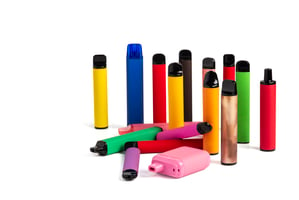On January 29, 2024, Prime Minister Rishi Sunak announced that disposable vapes would be banned in the UK as part of the Government’s plan to tackle the rise in youth vaping. The Government may use...
A Message to the DHSC - Don’t let politics take over pragmatism.
Nicotine

Oct 5, 2023 | Published by Dr. Nveed Chaudhary
Nicotine
Today, the UK Department of Health and Social Care (DHSC) published a white paper, “Stopping the start: our new plan to create a Smokefree Generation.” The paper outlines the government’s commitment to creating a smoke-free UK by 2030 and presents several potential strategies to achieve this.
Fantastically, the DHSC still acknowledges the reduction in risk of e-cigarettes compared to smoking combustible cigarettes and still sees e-cigarettes as part of the solution. They recognise that e-cigarettes have led to an extra 50,000 – 70,000 successful smoking quits per year and are committed to ensuring that e-cigarettes are critical to achieving their goal. They indicate that e-cigarettes are less harmful than cigarettes as the issue with cigarettes is the combustion of tobacco and the thousands of harmful chemicals found in cigarette smoke. Heated tobacco products, for example, where combustion is avoided, are also significantly less harmful than smoking combustible cigarettes.
To reduce the number of people smoking combustible cigarettes, the government is looking to a New Zealand-style legislation whereby the legal smoking age will increase from 18 annually to the point that any child that is 14 or younger today will never legally be allowed to buy tobacco products.
Furthermore, the paper highlights the MHRA’s commitment to supporting medicinally licensed vaping products. However, the language used states, “if the industry comes forward with a successful candidate,” strongly indicating that currently, there are not enough players in the tobacco and nicotine industry that are exploiting this opportunity.
What has rightly not been ignored is that the number of children who use e-cigarettes has tripled over the last three years. Vaping is much less harmful than smoking cigarettes but is not risk-free. Since nicotine is widely reported to affect cognitive development in the adolescent brain, the harms for children using nicotine must not be allowed to carry on.
The paper indicates that the recent surge in the number of children vaping is due to vaping products being “promoted in a way that appeals to children, through flavours and descriptions, cheap, convenient products and indoor marketing.”
Thus, the government is looking at seven proposals to tackle the youth vaping issue:
1. Restricting vape flavours.
2. Regulating vape packaging and product presentation.
3. Regulating point-of-sale displays.
4. Restricting the sale of disposable vapes.
5. Introducing an age restriction for non-nicotine vapes.
6. Exploring further restrictions for other nicotine consumer products such as nicotine pouches.
7. Preventing industry from giving out free samples of vapes to children.
These all seem like sensible measures, but what worries me is the potential for the government to lose the pragmatism they have shown around alternative nicotine products till now. Proposal number 1 is potentially a minefield. Yes, it is true that children primarily use Fruity and candy-flavoured products, but it is important to note that many UK adult smokers also enjoy these flavours to help them quit smoking. In the paper, the DHSC clearly acknowledges that 47% of adult vapers use fruity flavours and 6.2% use candy flavours; 6.2% may seem like a small number, but with approximately 6 million smokers in the UK, the banning of candy flavours could reduce the quitting opportunity for up to 370,000 smokers. The second proposal that could be problematic is number 4, “Restricting the sale of disposable vapes.” Restricting is one thing, but banning is another. There is no doubt that the convenience of disposable e-cigarettes is a facilitator in aiding the quitting challenge for adult smokers.
The final proposal, which has the potential to reduce the opportunities for adult smokers to stop smoking, is number 6, “exploring further restrictions for other nicotine consumer products such as nicotine pouches.” Nicotine pouches have the potential to be a phenomenal product to aid smoking cessation. The fact that nothing is inhaled into the lungs and that these pouches do not contain tobacco indicates that the risk profile of using these products is likely to be even lower than e-cigarettes. The issue currently is that nicotine pouches fall into a regulatory void. They are not included in the oral tobacco ban (as is Swedish snus) as they do not contain tobacco and are not covered by the Tobacco and Related Products Regulation (TRPR). Without any regulation surrounding them, there is no way in which their sales and marketing can be controlled. Bringing them in line with TRPR or acknowledging them as being similar to medicinal Nicotine replacement therapies (NRT) and bringing them under the same pharmaceutical regulations would allow for policing and enforcement against youth use.
We are at a critical juncture as we exit the political party conference season and as we enter 2024, which will be a general election year in the UK. The UK government must not be lured into making decisions on these life-saving products based on what will help them win another term in government.
It is clear that the combination of candy- and fruit-flavoured disposable e-cigarettes drives youth usage, and this is where the government must focus its efforts on restrictions. If nicotine pouches remain sitting in the current regulatory void, it may drive a new youth use situation in the future, and so as a defensive move, bringing them into line with a regulatory pathway is critical to protect both children and the choices available for smokers to quit smoking.
At the Global Forum for Nicotine and Tobacco in Seoul last month, the UK was widely credited for taking a very pragmatic and scientific evidence-based approach to alternative nicotine products. The UK lead the world; with this paper, the DHSC indicate that they are preparing to consolidate their leadership position further. Politics sometimes makes politicians do funny things…especially in election years. Our plea, from those who are staunch and passionate advocates for tobacco harm reduction, is for the government to keep adult smokers at the forefront of their minds alongside the current and future health of our children. The resulting policy decisions must protect our children but, at the same time, not limit the options for current adult smokers to quit smoking combustible cigarettes.
.webp?height=200&name=iStock-1421934394%20(2).webp)

